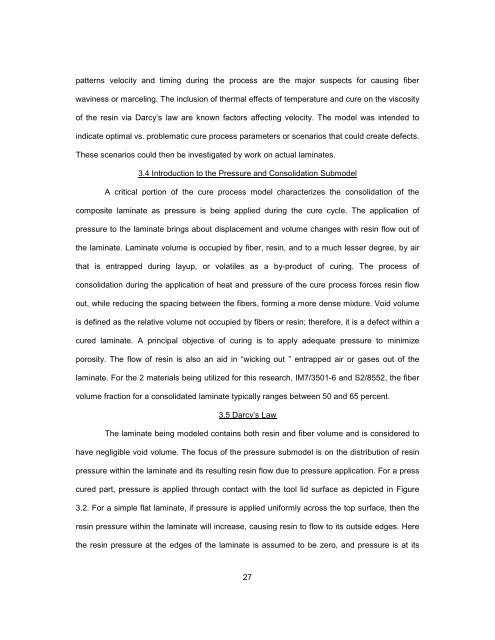TOOLED THICK COMPOSITES by ARVEN H. SAUNDERS III ...
TOOLED THICK COMPOSITES by ARVEN H. SAUNDERS III ...
TOOLED THICK COMPOSITES by ARVEN H. SAUNDERS III ...
You also want an ePaper? Increase the reach of your titles
YUMPU automatically turns print PDFs into web optimized ePapers that Google loves.
patterns velocity and timing during the process are the major suspects for causing fiber<br />
waviness or marceling. The inclusion of thermal effects of temperature and cure on the viscosity<br />
of the resin via Darcy’s law are known factors affecting velocity. The model was intended to<br />
indicate optimal vs. problematic cure process parameters or scenarios that could create defects.<br />
These scenarios could then be investigated <strong>by</strong> work on actual laminates.<br />
3.4 Introduction to the Pressure and Consolidation Submodel<br />
A critical portion of the cure process model characterizes the consolidation of the<br />
composite laminate as pressure is being applied during the cure cycle. The application of<br />
pressure to the laminate brings about displacement and volume changes with resin flow out of<br />
the laminate. Laminate volume is occupied <strong>by</strong> fiber, resin, and to a much lesser degree, <strong>by</strong> air<br />
that is entrapped during layup, or volatiles as a <strong>by</strong>-product of curing. The process of<br />
consolidation during the application of heat and pressure of the cure process forces resin flow<br />
out, while reducing the spacing between the fibers, forming a more dense mixture. Void volume<br />
is defined as the relative volume not occupied <strong>by</strong> fibers or resin; therefore, it is a defect within a<br />
cured laminate. A principal objective of curing is to apply adequate pressure to minimize<br />
porosity. The flow of resin is also an aid in “wicking out ” entrapped air or gases out of the<br />
laminate. For the 2 materials being utilized for this research, IM7/3501-6 and S2/8552, the fiber<br />
volume fraction for a consolidated laminate typically ranges between 50 and 65 percent.<br />
3.5 Darcy’s Law<br />
The laminate being modeled contains both resin and fiber volume and is considered to<br />
have negligible void volume. The focus of the pressure submodel is on the distribution of resin<br />
pressure within the laminate and its resulting resin flow due to pressure application. For a press<br />
cured part, pressure is applied through contact with the tool lid surface as depicted in Figure<br />
3.2. For a simple flat laminate, if pressure is applied uniformly across the top surface, then the<br />
resin pressure within the laminate will increase, causing resin to flow to its outside edges. Here<br />
the resin pressure at the edges of the laminate is assumed to be zero, and pressure is at its<br />
27
















